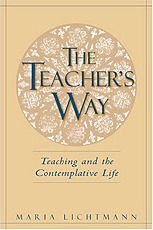Spiritual Practice: Depth, Relatedness, and Transcendence
"But how do we create a model of teaching that incorporates Thomas' joy, Guigo's contemplative journey of the heart, and Benedict's balance? Simply put, how do we make teaching a spiritual practice? . . . If Benedict and Guigo lead us to the depths of our hearts and beyond them to God, the intuitive contemplative dimensions, Thomas' spirituality connects us in love to the world around us, the cosmological contemplative dimension.
"Those who disparage practice (and I am one of them when I think back to my days sitting on the piano bench) might do well to remember that we are embodied beings, whose inner selves seek expression in action. I would like to rescue a notion of practice as flowing from our inner being to the world. We need to give form to our good intentions. I use technology, but I cultivate practice. The word technique, for many, particularly in K-12, conjures up too many quick fixes that turn us away from our own inner voices and instincts. We need technique as 'embodied grace.'
"Beginning any practice is as difficult as trying to water a dry garden with buckets of water, as St. Teresa of Avila (1515-1582) says about beginning the practice of prayer. At first, the water comes from a distance only through laborious human effort. Later, water simply wells up directly from the spring and begins to overflow without any human skill. Teresa's analogy is especially appropriate since it concerns deepening levels of meditation, involving a deeper connection to the inner life and to God. In many religious communities people simply ask, 'What is your practice?' not 'Have you been saved?' There is little of that faith accompli notion of completion. One group of teachers speaks of their daily practices in the simplest of terms: splashing cold water to honor the directions and the elements, reading a poem, pouring the warmth of a cup of coffee, lighting a candle to write, and to 'honor the light, the life force, and to open to receive what may come.' These practices and rituals become the meeting place of meaning and manners, of vision and practicality. Over time, the work we set out to do in a practice shifts to other areas of our life. Settling on a group of practices — like yoga, meditation, journaling, or those of lectio divina — forces us to navigate the middle ground between accomplishment and failure. When we commit ourselves to them faithfully, practices make us constant learners, give expression to our hopes, and join us to others engaged in them, that is, to a community of practitioners. Practices in effect become our 'Rule.'
"Teaching, an ancient art, embraces many practices. In relation to the tradition of contemplation, teaching is paradoxical practice; it encompasses Thomas Aquinas' 'mixed life' of contemplation and action, a constant dialectical swing between doing and being. In teaching, sometimes the mind seems busy planning and deciding, and at other times it simply waits, receiving ideas from many sources about what is going on in the classroom. In a polarized model of teaching, teacher as active, student as passive, it seems as if the waiting is all on one side — the student's side. But in a contemplative teaching style, the teacher learns to wait as the student finds voice and shares power. The spiritual practices of lectio, meditatio, oratio, and contemplatio — translated into attention, reflection, receptivity, and transformation — belong to those who teach as well as to those who are being taught.
"Contemporary culture may so eclipse our understanding of what it means to be religious — substituting the moralism of avoiding personal sin (where will predominates) or the gnosticism of private 'spiritual' knowledge (where intellect may predominate) or the tribalism of denominational religions (where club predominates) — that we need to outline some essential elements of spiritual practice to appreciate its merits. Spiritual practices are healthiest when they draw on religion's substantiality, its wisdom traditions, its 'trellises' or structures for supporting and sustaining personal efforts, and its communities of correction and affirmation. We can identify at least three elements of spiritual practices that Benedict, Guigo, and all serious practitioners exemplify: (1) psychological and spiritual depth: self-knowledge; (2) relatedness: acknowledging and strengthening relationship with others, including relationship to a tradition; and (3) not-doing: leaving ourselves really open to the working of the Spirit, to a transcendence that belies mere self-help."
